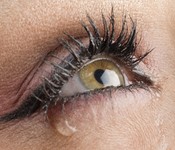Why do we cry when we're happy?
 When something good happens in our lives, many of us can't help but shed "tears of joy". The situations that provoke these tears vary greatly: parents seeing their child graduate from college, a couple reuniting after a long absence, or an athlete winning a contest. But why do we cry when we might expect to smile or laugh? There is a scientific explanation for tears of joy.
When something good happens in our lives, many of us can't help but shed "tears of joy". The situations that provoke these tears vary greatly: parents seeing their child graduate from college, a couple reuniting after a long absence, or an athlete winning a contest. But why do we cry when we might expect to smile or laugh? There is a scientific explanation for tears of joy.
According to Oriana Aragon, crying after an experience of intense positive emotion allows us to regain emotional balance. The scientist and her team from Yale University carried out an experiment, the results of which will soon be published in Psychological Science.
In order to verify the hypothesis, the scientists asked study participants to view a series of photos of babies some of whom had more distinctively infantile traits than others (a rounder face or bigger eyes). The participants' reactions were then measured and compared with how infantile the babies' traits were.
While the babies with the most infantile traits received the most attention, they also induced stronger "aggressive" reactions. Participants apparently showed a need to protect and care for them, while also expressing a desire to pinch their cheeks and "eat them alive."
For the researchers, this "dimorphous expression," in which a positive event is coupled with a negative emotional reaction, allows very strong positive emotions to be regulated in order to regain emotional balance more quickly. Indeed, they found that people demonstrating this type of expression also showed a greater decrease in positive emotion five minutes after viewing the images.
Conversely, this type of behavior could also explain situations like "nervous laughter," where a negative emotion leads to smiling or laughter.
Source: Aragón, O. R., Clark, M. S., Dyer, R. L., & Bargh, J. A. (in press) Dimorphous expressions of emotion: Evidence of concept in aggressive displays toward cute stimuli, Psychological Science.







